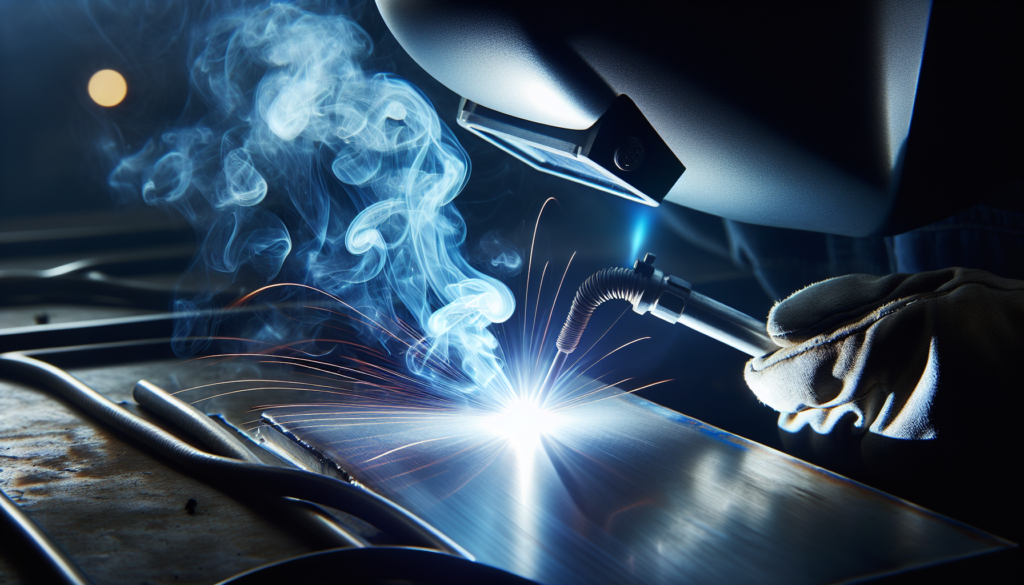Are you curious about the fascinating world of welding with TIG? If so, get ready to be captivated by the art of using a Tungsten Inert Gas (TIG) welding machine. In this article, you will be introduced to the basics of TIG welding, uncovering its unique abilities to create clean and precise welds. Whether you are a beginner or an experienced welder, prepare yourself to discover the endless possibilities that TIG welding brings to the table. Get ready to ignite your passion for welding and embark on an exciting journey into the world of TIG welding.
What is TIG Welding?
TIG welding, also known as Gas Tungsten Arc Welding (GTAW), is a precise and versatile welding process that uses a non-consumable tungsten electrode to create the weld. It utilizes a shielding gas, typically argon, to protect the weld area from atmospheric contamination. TIG welding produces high-quality welds with excellent aesthetics and is commonly used in industries such as automotive, aerospace, and art.
TIG Welding Process
The TIG welding process involves the following steps:
- Arc Starting: To initiate the arc, the tungsten electrode is brought into contact with the workpiece and then slowly retracted while the shielding gas is flowing.
- Arc Stability: Once the arc is established, the welder maintains a stable arc length to ensure consistent heat transfer.
- Fusion: The heat generated by the arc melts the base metal and the filler metal (if used), creating the weld pool.
- Shielding: The shielding gas forms a protective atmosphere around the weld pool, preventing contamination from the air.
- Filler Metal Addition: If necessary, the welder adds filler metal to enhance the weld strength and control the weld profile.
- Cooling: After completing the weld, the workpiece is allowed to cool down gradually to avoid distortion or cracking.
Advantages of TIG Welding
TIG welding offers several advantages over other welding processes, making it a popular choice for many applications.
- Precision: TIG welding allows for precise control of heat and filler metal, resulting in high-quality, clean welds.
- Versatility: It can be utilized for various materials, including stainless steel, aluminum, copper, and even exotic metals.
- Aesthetics: TIG welds are known for their attractive appearance, making them suitable for projects where visual appeal is important.
- Low Heat Input: The low heat input of TIG welding minimizes distortion and heat-affected zones, especially in thin materials.
- No Spatter: Since TIG welding does not use a consumable electrode, there is no spatter or splatter during the welding process.
- No Flux Required: Unlike some other welding processes, TIG welding does not require the use of flux, which simplifies post-weld cleaning.
- Low Fumes and Noise: TIG welding produces minimal fumes and noise, creating a safer and more comfortable working environment.

Equipment and Tools
To perform TIG welding, several equipment and tools are necessary.
TIG Welding Machine
The heart of the TIG welding setup is the TIG welding machine, also known as a power source or TIG welder. This machine supplies the necessary electrical current and controls various welding parameters, including amperage, arc starting, and gas flow.
Tungsten Electrodes
Tungsten electrodes are essential for TIG welding as they provide the heat necessary to create the arc. They are available in various compositions, such as pure tungsten, thoriated tungsten, and ceriated tungsten, each offering different arc characteristics and longevity.
Gas Source
A reliable gas source, typically argon or a mixture of argon and helium, is required for TIG welding. The gas is delivered through a regulator to control the flow rate and ensure proper shielding of the weld.
Filler Metal and Shielding Gas
While not always necessary, filler metal can be added to the weld to increase strength or achieve desired aesthetics. The choice of filler metal depends on the base material being welded. Additionally, a proper shielding gas, typically argon or a mixture, is required to protect the weld zone from atmospheric contamination.
Personal Protective Equipment (PPE)
TIG welding, like any welding process, requires the use of appropriate personal protective equipment to ensure safety. This includes a welding helmet with a shade appropriate for TIG welding, safety glasses, welding gloves, and flame-resistant clothing.
Preparing for TIG Welding
To ensure successful TIG welding, proper preparation is crucial.
Surface Preparation
Before starting the welding process, it is essential to prepare the workpiece’s surface. This involves removing any dirt, oil, or rust that could interfere with the weld quality. A clean surface ensures proper fusion and reduces the risk of contamination.
Fit-Up and Alignment
Proper fit-up and alignment of the workpieces to be welded are crucial for achieving accurate and strong welds. This includes ensuring the correct joint configuration, gap alignment, and securing the pieces in place using clamps or fixtures.
Electrode Selection
Choosing the correct tungsten electrode is essential for TIG welding success. Factors to consider include the base material, thickness, desired weld characteristics, and welding current. The correct electrode diameter and type should be selected accordingly.
Setting up the TIG Welding Machine
Before starting the welding process, it is vital to configure the TIG welding machine accurately. This includes setting the appropriate amperage, choosing the correct welding mode (AC or DC), adjusting the gas flow rate, and ensuring proper connections of cables and hoses.

TIG Welding Techniques
Mastering various TIG welding techniques is essential for achieving high-quality welds.
Arc Starting
Proper arc starting is crucial to avoid tungsten electrode contamination and ensure a stable arc. Techniques such as scratch starting, lift arc starting, or high-frequency starting can be employed, depending on the specific requirements and capabilities of the TIG welding machine.
Movement and Travel Speed
Maintaining consistent movement and travel speed is crucial for achieving uniform welds with proper fusion. A steady hand and controlled movement help to prevent overheating or laying excessive filler metal.
Filler Metal Manipulation
When using filler metal, the welder must learn to control its deposition while maintaining a stable arc. Proper manipulation techniques, such as finger or hand feeding, help achieve the desired weld profile and strength.
Heat Control
Controlling the heat input during TIG welding is crucial to prevent distortion, overheating, or burning through thin materials. Proper adjustment of the welding current and the use of heat sinks or foot pedals can help achieve precise heat control.
Common Challenges in TIG Welding
TIG welding, like any welding process, presents certain challenges. Understanding and addressing these challenges can help improve welding quality.
Contamination
TIG welding requires a clean and contamination-free environment to achieve high-quality welds. Any contamination, such as oil, paint, or moisture on the workpiece surface, can lead to weld defects or reduced integrity. Proper cleaning and surface preparation are essential to avoid contamination.
Tungsten Damage
Tungsten electrodes are susceptible to damage and degradation during welding. Factors like improper grinding, excessive current, or improper gas shielding can lead to electrode contamination, tungsten inclusion, or electrode failure. Regular inspection and proper handling can help mitigate tungsten damage.
Porosity
Porosity, or the presence of small gas pockets in the weld, can weaken the weld’s integrity. It is typically caused by inadequate shielding gas coverage, improper gas flow rates, or contaminated filler metal. Proper gas shielding and filler metal selection are crucial for minimizing porosity.
Weld Discoloration
Weld discoloration, often seen as a rainbow-like appearance on stainless steel or heat-affected zones, can affect the aesthetics and corrosion resistance of the weld. It is caused by excessive heat input, improper gas coverage, or inadequate cleaning of the base material. Careful heat control and proper surface preparation help minimize weld discoloration.
Welding Thin Materials
TIG welding thin materials can be challenging due to their susceptibility to distortion and burn-through. Proper heat control, reduced travel speed, and the use of appropriate filler metals can help mitigate these issues.
TIG Welding Applications
TIG welding finds application in various industries due to its versatility and superior weld quality.
Automotive Industry
TIG welding is widely used in the automotive industry for joining critical components such as exhaust systems, engine parts, and suspension components. It provides strong and visually appealing welds that meet demanding specifications.
Aerospace Industry
The aerospace industry extensively utilizes TIG welding for fabricating aircraft components, such as fuselage sections, fuel tanks, and engine components. TIG welds ensure structural integrity and meet the stringent quality standards required in the aerospace sector.
Pipe and Tube Welding
TIG welding is commonly used for pipe and tube welding, both in industrial and residential applications. It offers precise control over the weld pool, allowing for leak-free joints and excellent weld aesthetics.
Artwork and Decorative Metal
TIG welding’s ability to produce clean, precise, and visually appealing welds makes it suitable for artwork and decorative metal fabrication. Artists and craftsmen use TIG welding to create intricate designs, sculptures, and ornamental pieces.
TIG vs. Other Welding Processes
TIG welding has unique advantages and characteristics compared to other popular welding processes.
TIG vs. MIG Welding
TIG welding offers superior control and precision compared to MIG (Metal Inert Gas) welding. While MIG welding is faster and more suitable for thicker materials, TIG welding is preferred for thinner materials and applications where aesthetics and quality are crucial.
TIG vs. Stick Welding
TIG welding and Stick welding (Shielded Metal Arc Welding) have different applications. TIG welding is ideal for thin materials, critical welds, and applications requiring precise control and aesthetics. Stick welding, on the other hand, is more suitable for heavy fabrication, outdoor welding, and repairs.
TIG Welding Tips and Best Practices
To achieve the best results with TIG welding, the following tips and best practices are recommended:
Maintain a Clean Workspace
Keeping the workspace clean and free from debris, oil, or other contaminants helps ensure high-quality welds and minimizes the risk of contamination.
Proper Electrode Angle
Maintaining the correct electrode angle ensures optimal heat transfer and penetration. The ideal angle typically ranges between 70-90 degrees, depending on the joint configuration and welding position.
Controlled Movement
Maintaining a steady and controlled movement while welding prevents overheating, underfilling, or overfilling of the weld. Practice and experience are key in mastering controlled movement.
Avoidance of Excessive Heat
Excessive heat input can lead to distortion, warping, or burn-through, especially in thin materials. Controlling the heat input through proper amperage settings, travel speed, and heat management techniques is essential.
Frequent Inspection and Testing
Regularly inspecting and testing the welds for defects ensures the weld quality and integrity. Non-destructive testing methods such as visual inspection, dye penetrant testing, or radiographic examination can be employed when required.
Training and Certification
To become a proficient TIG welder, formal training programs and certifications are recommended.
Formal Training Programs
Attending a reputable welding school or vocational training program specializing in TIG welding provides comprehensive theoretical knowledge and hands-on practice. These programs cover safety procedures, welding techniques, equipment operation, and material-specific considerations.
Certifications and Qualifications
Obtaining welding certifications, such as those offered by organizations like the American Welding Society (AWS), is crucial for demonstrating proficiency in TIG welding. These certifications validate a welder’s skills and knowledge, enabling them to pursue career opportunities in various industries.
Conclusion
TIG welding is a versatile and precise welding process that offers numerous advantages in terms of weld quality, aesthetics, and applicability across different industries. By understanding the TIG welding process, equipment, techniques, and best practices, you can become proficient in TIG welding and embark on a rewarding career in the welding industry. Remember to prioritize safety, practice regularly, and keep up with advancements in TIG welding technology and techniques to excel in this field.
